Class 10 Civics Chapter 2 Previous Year Questions - Federalism
Previous Year Questions 2024
Q1: Choose the correct answers to the questions from the given options. Match Column-I with Column-II and choose the correct option from the following: (1 Mark) (CBSE 2024)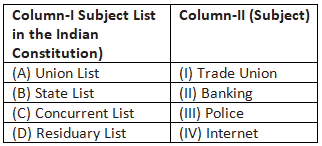
Options:
(a) (A)-(IV ), (B)-(I), (C)-(III), (D)- (IV)
(b) (A)-(II), (B)-(III), (C)-(I), (D)- (IV)
(c) (A)-(I), (B)-(II), (C)-(IV ), (D)- (III)
(d) (A)-(III), (B)-(IV ), (C)-(II), (D)- (I)
 View Answer
View AnswerAns: (b)
(A) Union List - (II) Banking: Banking is primarily managed by the central government, which falls under the Union List.
(B) State List - (III) Police: The police force is a subject that is managed by individual states, so it belongs to the State List.
(C) Concurrent List - (I) Trade Union: Trade unions can be regulated by both the central and state governments, making them a subject in the Concurrent List.
(D) Residuary List - (IV) Internet: The internet is a newer subject not explicitly mentioned in the Constitution, thus it falls under the Residuary List where powers are given to the government to legislate on subjects not specified.
Previous Year Questions 2023
Q2: Read the given source and answer the questions that follow: (4 & 5 Marks) (2023)Language Diversity of India
How many languages do we have in India? The answer depends on how one counts it. The latest information that we have is from the Census of India held in 2011. This census recorded more than 1300 distinct languages which people mentioned as their mother tongues. These languages were grouped together under some major languages. For example languages like Bhojpuri, Magadhi, Bundelkhandi, Chhattisgarhi, Rajasthani and many others were grouped together under 'Hindi'. Even after this grouping, the Census found 121 major languages. Of these 22 languages are now included in the Eighth Schedule of the Indian Constitution and are therefore called 'Scheduled Languages'. Others are called 'Non-Scheduled Languages'. In terms of languages, India is perhaps the most diverse country in the world.
(I) Explain the importance of language diversity in India.
(II) Differentiate between Scheduled and Non-Scheduled Languages.
(III) The fusion of languages has united the country into one cultural entity.' Explain the statement with an example.
 View Answer
View AnswerAns: (i) Importance of Language Diversity in India:
- India's vast number of languages contributes to its cultural diversity.
- This diversity helps to preserve the unique identities of various communities.
(ii) Difference Between Scheduled and Non-Scheduled Languages:
- Scheduled Languages: There are 22 languages recognised in the Indian Constitution, known as scheduled languages.
- Non-Scheduled Languages: All other languages not included in this list are referred to as non-scheduled languages.
(iii) Fusion of Languages and Cultural Unity: The statement highlights how the blending of diverse languages and cultures has fostered a shared national identity. For instance, unlike Sri Lanka, Indian leaders have been careful in promoting Hindi, allowing for a more inclusive approach to language use.
Q3: Match Column-A with Column-B and choose the correct option. (1 Mark) (2023)
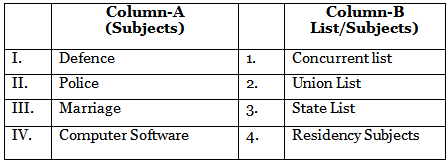
(a) I - 4 , II - 3, III - 1, IV - 2
(b) I - 3 , II - 4, III - 1, IV - 2
(c) I - 4 , II - 1, III - 3, IV - 2
(d) I - 2 , II - 3, III - 1, IV - 4
 View Answer
View AnswerAns: (d)
I. Defence - 2. Union List: Defence is managed by the central government, which is why it falls under the Union List.
II. Police - 3. State List: The police force is a state subject, meaning individual states have the power to legislate on this issue, so it belongs to the State List.
III. Marriage - 1. Concurrent List: Laws regarding marriage can be made by both the central and state governments, which is why it is included in the Concurrent List.
IV. Computer Software - 4. Residual Subjects: Since computer software is a newer subject not specifically mentioned in the Constitution, it falls under the Residual Subjects, allowing the government to make laws on it.
Q4: Match the column - A with column - B and choose the correct option. (1 Mark) (2023)
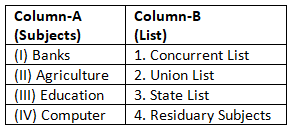 (a) I - 4 , II - 3, III - 1, IV - 2
(a) I - 4 , II - 3, III - 1, IV - 2
(b) I - 3 , II - 4, III - 1, IV - 2
(c) I - 2 , II - 3, III - 1, IV -4
(d) I - 4 , II - 2, III - 1, IV - 3
 View Answer
View AnswerAns: (c)
(I) Banks - 2. Union List: Banking is primarily managed by the central government, so it falls under the Union List.
(II) Agriculture - 3. State List: Agriculture is mainly regulated by individual states, making it a subject in the State List.
(III) Education - 1. Concurrent List: Education is a subject where both the central and state governments can make laws, which is why it is included in the Concurrent List.
(IV) Computer - 4. Residuary Subjects: The topic of computers is newer and not specifically mentioned in the Constitution, placing it in the Residual Subjects category, allowing the government to legislate on it.
Q5: Identify the administrative level of Indian Government with the help of the information given in the box and choose the correct option: (1 Mark) (CBSE 2023)
1. Power shared between Central to Local Government.
2. The State Governments are required to share some powers and revenue with them.
3. It is called a three tier government._________
(a) Dictatorial System
(b) Unitary Federal System
(c) Decentralised System
(d) Imperialistic System
 View Answer
View AnswerAns: (c)
A Decentralised System means that power and responsibilities are distributed from the central government to local governments, allowing them to make decisions about local matters. In India, this involves a three-tier government structure with the central, state, and local levels, where state governments share powers and revenue with local authorities, enhancing local governance and participation.
Q6: Read the given extract and answer all questions. (4 Marks) (2023)
DECENTRALISATION IN INDIA
When power is taken away from Central and State governments and given to local government, it is called decentralization. The basic idea behind decentralization is that there are a large number of problems and issues which are best settled at the local level. People have better knowledge of problems in their localities. They also have better ideas on where to spend money and how to manage things more efficiently. Besides at the local level it is possible for the people to directly participate in decision making. This helps to inculcate a habit of democratic participation. Local government is the best way to realise one important principle of democracy, namely local self-government. The need for decentralisation was recognized in our Constitution. Since then, there have been several attempts to decentralize power to the level of villages and towns. Panchayats in villages and muncipalities in urban areas were set up in all the States. But these were directly under the control of State Governments. Elections to these local governments were not held regularly.
(i) Explain Decentralization in democracy.
(ii) Explain the importance of Local self Government in democracy.
(iii) Describe any two steps taken by Indian government for decentralization.
 View Answer
View AnswerAns: (i) Decentralisation in democracy refers to the transfer of power from central and state governments to local governments. This process allows local authorities to address issues more effectively, as they have a better understanding of local problems.
(ii) The importance of local self-government includes:
- Local issues are often best resolved at the community level.
- Residents possess better insights into spending priorities and resource management.
- It encourages direct participation in decision-making, fostering a culture of democratic involvement.
(iii) Two significant steps taken by the Indian government for decentralisation are:
- Establishment of Panchayats in villages and municipalities in urban areas across all states.
- Mandatory regular elections for local government bodies, ensuring local representation.
Previous Year Questions 2022
Q7: Which one of the following countries is the example of Holding together federation? (2022)(a) Australia
(b) India
(c) U.SA
(d) Switzerland
 View Answer
View AnswerAns: (b)
India is an example of a holding together federation.
Here are some key points:
- In a holding together federation, the central government is typically more powerful than the states.
- Different states may have unequal powers, with some granted special rights.
- Other examples include Spain and Belgium.
In contrast, Australia, the USA, and Switzerland are examples of coming together federations.
Q8: Identify the correct feature of Unitary form of government from the following options. (2022) [Old NCERT]
(a) There are two or more levels of government.
(b) Different tiers of government govern the same citizens.
(c) Each tier of government has its own jurisdiction.
(d) The sub-units are subordinate to the central government.
 View Answer
View AnswerAns: (d)
In a unitary form of government:
- The sub-units are subordinate to the central government.
- There is either one level of government or the lower levels follow the orders of the central government.
This means that the central government has the authority to direct provincial or local governments.
Q9: Choose the correct pair among the following: (2022) [Old NCERT]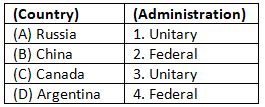 (a) A - 1
(a) A - 1
(b) B - 2
(c) C - 3
(d) D - 4
 View Answer
View AnswerAns: (d)
Russia, Canada and Argentina are federal countries. China is a unitary country.
Q10: Which of the following countries is an example of 'coming together federation? (2022)
(a) United States of America
(b) India
(c) Spain
(d) Belgium
 View Answer
View AnswerAns: (a)
- The United States is an example of a 'coming together' federation.
- In this type of federation, constituent states typically have equal power.
- In contrast, India, Spain, and Belgium represent 'holding together' federations.
- In holding together federations, the central government usually has more power than the states.
Q11: Which one of the following subjects is included in the Union list? (Term-1,2021-22)
(a) Communication
(b) Trade
(c) Commerce
(d) Irrigation
 View Answer
View AnswerAns: (a)
Communication is included in the Union list
Q12: Which one of the following subjects is included in the State list? (Term-1, 2021-22)
(a) Banking
(b) Business
(c) Currency
(d) Communication
 View Answer
View AnswerAns: (b)
Business is included in the State list. Banking, currency and communication are included in the Union list.
Q13: Which one of the following subjects is included in the Concurrent List? (Term-1,2021-22)
(a) Trade
(b) Commerce
(c) Agriculture
(d) Marriage
 View Answer
View AnswerAns: (d)
Concurrent list includes subjects of common interest to both the Union Government as well as the State Government. These are education, forest, marriage, adoption and succession.
Q14: Match Column I with Column II and choose the correct option: (2022)
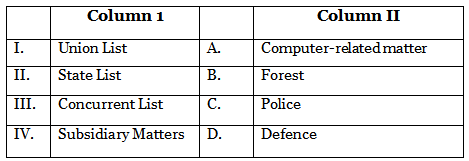
(a) l - C, II - D, III - B, IV - A
(b) I - A, II - B, III -C, IV - D
(c) l - D, II - C, III - B, IV - A
(d) l - B, II - A, III - C, IV - D
 View Answer
View AnswerAns: (c)
(I) Union List - D. Defence: Defence is primarily a central government responsibility, so it falls under the Union List.
(II) State List - C. Police: The police force is managed by state governments, which makes it a subject in the State List.
(III) Concurrent List - B. Forest: Forest management can be legislated by both the central and state governments, placing it in the Concurrent List.
(IV) Subsidiary Matters - A. Computer-related matter: Since computer-related issues are more recent and not specifically detailed in the Constitution, they fall under Subsidiary Matters.
Previous Year Questions 2021
Q15: Identify the correct feature of Unitary form of government from the following options:
(a) There are two or more levels of government.
(b) Different tiers of government govern the same citizens.
(c) Each tier of government has its own jurisdiction.
(d) The sub-units are subordinate to the central government. (CBSE Term-1 2021)
 View Answer
View AnswerAns: (d)
In a Unitary form of government, all powers are centralized at the national level. The central government holds the primary authority, and any administrative divisions (sub-units) function under its control. The sub-units do not have independent jurisdiction but instead operate as extensions of the central government, with limited powers that are often delegated by the central authority.
The other options are characteristics of a federal form of government, where:
(a) There are two or more levels of government.
(b) Different tiers of government govern the same citizens.
(c) Each tier has its own jurisdiction and powers defined by the constitution.
Therefore, the correct answer is (d) The sub-units are subordinate to the central government.
Q16: Which one of the following countries is the example of ‘Holding together federation’?
(a) Australia
(b) India
(c) U.S.A.
(d) Switzerland (CBSE Term-1 2021)
 View Answer
View AnswerAns: (b)
In a Holding Together Federation, the central government shares power with constituent states or regions, but the division of power is typically unequal, with the central authority retaining more control. This model is used to unify a country with diverse regions and cultural groups, aiming to hold them together under a single federal structure.
India is an example of a Holding Together Federation, as the union government holds significant power, and states have varying degrees of autonomy.
Q17: Which one of the following subjects is included in the Concurrent List?
(a) Trade
(b) Commerce
(c) Agriculture
(d) Marriage (CBSE Term-1 2021)
 View Answer
View AnswerAns: (d)
In the Indian Constitution, subjects are divided into three lists: the Union List, the State List, and the Concurrent List.
(i) The Concurrent List includes subjects on which both the central and state governments can legislate. However, in case of a conflict, the central law prevails.
(ii) Marriage is included in the Concurrent List, allowing both the central and state governments to make laws regarding marriage.
The other options are part of different lists:
(i) Trade and Commerce are typically included in the Union and State Lists, depending on whether they are inter-state or intra-state.
(ii) Agriculture is in the State List, giving states the power to legislate on it.
Therefore, the correct answer is (d) Marriage.
Q18: Choose the correct pair among the following: (CBSE Term-1 2021)
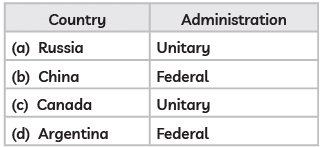
 View Answer
View AnswerAns:
(a) Russia - Unitary: Incorrect. Russia is a federal country, with powers divided between the central government and various federal subjects.
(b) China - Federal: Incorrect. China has a unitary system, where the central government holds primary authority, and administrative divisions operate under its control.
(c) Canada - Unitary: Incorrect. Canada is a federal country, with powers shared between the national government and provinces.
(d) Argentina - Federal: Correct. Argentina operates as a federal country, with powers divided between the national government and its provinces.
Therefore, the correct answer is (d) Argentina - Federal.
Previous Year Questions 2020
Q19: Rewrite the correct statement: (2020 C)India, Spain and Belgium are examples of ‘Coming Together Federation'.
 View Answer
View AnswerAns: India, Spain, and Belgium are examples of a 'holding together federation'.
- In this type of federation, the central government holds more power than the states.
- States may have unequal powers, with some granted special authorities.
- This structure allows for a balance between the national and state governments.
Q20: Rewrite the correct statement: (2020 C) [Old NCERT]
The Union Government as well as the State Governments can make laws on State subjects like forest, trade unions, marriage, etc.
 View Answer
View AnswerAns: The Union Government and State Governments can make laws on subjects that are of shared interest, known as concurrent subjects. Examples include:
- Forests
- Trade unions
- Education
- Marriage
If there is a conflict between laws made by both governments, the law passed by the Union Government takes precedence.
Q21: Describe any three features of 'federal government’. (2020)
 View Answer
View AnswerAns: The three features of a federal government are:
- Power distribution: The central government shares some powers with state governments.
- Separation of powers: Authority is divided among the legislature, executive, and judiciary.
- Elected officials: Those in office hold supreme power within the government.
Q22: Describe any three features of 'unitary government’. (2020) [Old NCERT]
 View Answer
View AnswerAns: Three features of unitary government are:
- Centralisation: A unitary government has a centralised structure, meaning most powers are held by the central authority.
- Supremacy: The central government holds supreme power over all administrative divisions.
- Limited Autonomy: Local divisions, such as states or districts, have less authority compared to the central government.
Q23: Describe any three characteristics of distribution of power between the center and states in India. (2020)
 View Answer
View AnswerAns: The Constitution clearly provided a three-fold distribution of legislative powers between the Union Government and the State Governments. Thus, it contains three lists.
List of Jurisdiction:
(i) Union List: Union List includes subjects of national importance; such as defence of the country, foreign affairs, banking, communications and currency. They are included in this list because we need a uniform policy on these matters throughout the country. The Union Government alone can make laws relating to the subjects mentioned in the Union List.
(ii) Concurrent List: Concurrent List includes subjects of common interest such as education, forest, trade unions, marriage, adoption and succession. Both the Union as well as the State Governments can make laws on the subjects mentioned in this list. If their laws conflict with each other, the law made by the Union Government will prevail.
(iii) State List: State List contains subjects of State and local importance such as police, trade, commerce, agriculture and irrigation. The State Governments alone can make laws relating to the subjects mentioned in the State List.
(iv) Residuary List: Anything out of purview of above mentioned list is taken as residuary subject. Union Government has the power to legislate on these subjects.
Q24: Enumerate the features of federalism. (2020)
 View Answer
View AnswerAns: The features of federalism include:
- There are two or more levels of government.
- Each level has its own jurisdiction over specific areas like legislation, taxation, and administration.
- The constitution defines the powers of each government level.
- Changes to fundamental constitutional provisions require agreement from both levels of government.
- Courts interpret the constitution and resolve disputes between government levels.
- Revenue sources for each government level are clearly defined to ensure financial independence.
- The federal system aims to maintain national unity while respecting regional diversity.
Q25: Federalism is a system of government in which the power is divided between a central authority and various constituent units of the country. Support the statement in reference of India. (2020)
 View Answer
View AnswerAns: Federalism is a system of government where power is shared between a central authority and various units within the country. In India, this is evident through the following points:
- India has multiple levels of government, each governing the same citizens.
- Each level has its own jurisdiction over specific areas like legislation, taxation, and administration.
- The Constitution clearly defines the powers and responsibilities of each tier, ensuring their existence is constitutionally protected.
- Changes to fundamental provisions of the Constitution cannot be made unilaterally; they require agreement from both the central and state governments.
- The courts have the authority to interpret the Constitution and the powers of different government levels.
Q26: Which institution has been created in each State of India to conduct Panchayat and Municipal elections? (2020)
 View Answer
View AnswerAns: The State Election Commission has been established in each state of India to oversee the conduct of panchayat and municipal elections. This independent body ensures that elections are held regularly and fairly.
- It is responsible for managing the electoral process at the local level.
- The commission guarantees that elections are conducted in accordance with the law.
- It plays a crucial role in strengthening local governance.
Q27: Describe the rationale behind the implementation of Decentralisation in India. (2020)
OR
Explain the basic idea behind decentralisation of political power in India. (2019)
 View Answer
View AnswerAns: The basic idea behind decentralisation is that there are a large number of problem and issues which are best settled at the local level, people have better knowledge about problems in their localities. They also have better idea about where to spend money and how to manage things more efficiently. Besides at the local level, it is possible for the people to directly participate in decision making. This helps to inculcate a habit of democratic participation. Local government is the best way to realise one important principle of democracy, namely local self-government.
Q28: Describe the nature of the Panchayati Raj System in India. (2020)
 View Answer
View AnswerAns: Nature of the Panchayati Raj System in India:
- The Gram Panchayat is a council made up of ward members, known as panchs, and a president called the sarpanch.
- Members are directly elected by the adult population of the village or ward.
- It serves as the main decision-making body for the village.
- In 1992, the Constitution was amended to establish a more effective three-tier system: Gram Panchayat, Block Samiti, and Zila Parishad.
Q29: Consider the following statements regarding language policy of Indian federation.
(I) Hindi was identified as the official language.
(II) Besides Hindi, there are 21 other languages recognised as scheduled languages.
(III) English can be used along with Hindi for official purpose.
Choose the combination that provides the correct statement(s) from the following :
(a) (I) and III
(b) (I) and (II)
(c) Only (I)
(d) (I), (II) and (III) (CBSE 2020)
 View Answer
View AnswerAns: (d)
All three statements regarding the language policy of the Indian federation are correct:
(I) Hindi was identified as the official language: Correct. Hindi, in the Devanagari script, was designated as the official language of India under Article 343 of the Indian Constitution.
(II) Besides Hindi, there are 21 other languages recognized as scheduled languages: Correct. Initially, there were 14 scheduled languages, but this number has expanded to 22, including Hindi, under the Eighth Schedule of the Constitution.
(III) English can be used along with Hindi for official purposes: Correct. English continues to be used for official purposes along with Hindi, especially in non-Hindi-speaking states and for communication between the central and state governments.
Since all statements are correct, the answer is (d) (I), (II) and (III).
Q30: State any one step taken in Belgium to rule out the problem of regional differences and cultural diversities. (CBSE 2020)
 View Answer
View AnswerAns: The Constitution of Belgium took a significant step to address regional differences and cultural diversities by ensuring equality in representation. This was achieved by:
- Maintaining an equal number of French and Dutch speakers in the central government.
- Preventing any single community from dominating decision-making.
Q31: Describe the features of federalism in India. (CBSE 2020)
 View Answer
View AnswerAns: The main features of federalism in India are as follows:
- Two or more levels of government: India has a central government and state governments, with a third tier of local governance through Panchayats and Municipalities.
- Same citizens with separate jurisdiction: Different levels of government govern the same citizens, but each has its own authority over specific areas like legislation, taxation, and administration.
- Jurisdiction specified by the constitution: The powers of each government level are clearly defined in the constitution, ensuring their existence and authority are constitutionally protected.
- No unilateral constitutional changes: Fundamental provisions of the constitution cannot be changed by one level of government alone; consent from both levels is required.
- Sources of revenue: Each government level has clearly defined sources of revenue, ensuring financial independence.
Previous Year Questions 2019
Q32: Name any two subjects that are included in the Concurrent List. How are laws made on these subjects? Explain. (2019) View Answer
View AnswerAns: Concurrent List: Concurrent List includes subjects of common interest such as education, forest, trade unions, marriage, adoption and succession. Both the Union as well as the State Governments can make laws on the subjects mentioned in this list. If their laws conflict with each other, the law made by the Union Government will prevail.
Q33: How is sharing of power between the union and the state government basic of the structure of the constitution of India? Explain. (2019)
 View Answer
View AnswerAns: The sharing of power between the Union Government and the State governments, there is power-sharing which is basic to the structure of the Constitution. It is not easy to make changes to this power-sharing arrangement. The Parliament cannot on its own change this arrangement. Any change to it has to be first passed by both the Houses of Parliament with at least two-thirds majority. Then it has to be ratified by the legislatures of at least half of the total states.
Q34: Describe any three steps taken to strengthen the local self-governments by the Constitutional Amendment, 1992. (CBSE 2019, 18)
OR
Explain the steps taken by the Indian Government in 1992 to make the third-tier of democracy more powerful. (2019)
 View Answer
View AnswerAns: A significant step towards decentralisation and strengthening local self-governments was taken in 1992 with the amendment of the Constitution. This amendment aimed to empower the third tier of democracy by granting constitutional status to local governing bodies.
- Regular Elections: It is now a constitutional requirement to hold regular elections for local government bodies. Each State has established an independent State Election Commission to oversee these elections.
- Reservation of Seats: Seats are reserved in local governing bodies for Scheduled Castes, Scheduled Tribes, and Other Backward Classes. Additionally, at least one-third of all positions are reserved for women.
- Power and Revenue Sharing: State governments must share certain powers and revenue with local government bodies, although the specifics can vary by State.
Q35: Describe the importance of a third-tier of government in a vast country like India. (2019)
 View Answer
View AnswerAns: Importance of third-tier government:
- Local Problem Solving: Many issues are best addressed at the local level, as residents understand their communities better.
- Resource Management: Locals have better insights on how to allocate resources effectively.
- Direct Participation: The local level allows people to engage directly in decision-making processes.
- Democratic Engagement: This fosters a culture of democratic participation among citizens.
Q36: Which government has the power to legislate on ‘Residuary’ subjects in India? (CBSE 2019)
 View Answer
View AnswerAns: The Union Government has the authority to legislate on residuary subjects in India. These subjects are those not specified in the Constitution's three lists:
- Union List: Covers national issues like defence and foreign affairs.
- State List: Includes local matters such as police and agriculture.
- Concurrent List: Contains subjects of mutual interest, like education and marriage.
Previous Year Questions 2018
Q37: Describe any three provisions of amendment made in Indian constitution in 1992 for making. ‘Three-Tier’ government more effective and powerful. (CBSE 2018)
 View Answer
View AnswerAns: Three provisions of the 1992 amendment to the Indian Constitution that enhance the effectiveness of the 'Three-Tier' government are:
- Regular Elections: It is now mandatory to hold regular elections for local government bodies.
- Reservation of Seats: Seats are reserved for the Scheduled Castes, Scheduled Tribes, and Other Backward Classes in elected bodies.
- Women's Representation: At least one-third of all positions in local governance are reserved for women.
- State Election Commission: Each state has established an independent State Election Commission to oversee panchayat and municipal elections.
- Power Sharing: State governments must share certain powers and revenues with local government bodies.
Q38: Describe any three steps taken to strengthen local self-governments, by the Constitutional Amendment, 1992. (CBSE 2018)
 View Answer
View AnswerAns: Steps taken to strengthen local self-governments by the Constitutional Amendment in 1992 include:
- Regular elections to local government bodies are now mandatory.
- Seats are reserved for Scheduled Castes, Scheduled Tribes, and Other Backward Classes in elected bodies.
- At least 33% of the seats are reserved for women in all elected bodies.
Previous Year Questions 2017
Q39: List under which both the Union and State Governments can make laws under the federal system in India. (2017)
 View Answer
View AnswerAns: Concurrent List
The Concurrent List in India is a category of subjects where both the Union and State Governments can make laws. This includes:
- Education
- Forests
- Trade
- Marriages
Both levels of government share the responsibility for these subjects, allowing for a collaborative approach to legislation.
Q40: What is the system of Panchayati Raj? (CBSE 2017)
 View Answer
View AnswerAns: In India, the Panchayati Raj functions as a system of governance in which gram panchayats are the basic units of local administration. The system has three levels: Gram Panchayat (village level), Block Samiti or Panchayat Samiti (block level), and Zila Parishad (district level).
Q41: Why was the States re organisation commission formed? (CBSE 2017, 16)
 View Answer
View AnswerAns: It was formed to recommend creation of states in India on the basis of different languages.
Q42: “India has a large cultural, regional and religious diversity but there is unity among people”. What factors are responsible for this? Elaborate. (CBSE 2017, 16)
 View Answer
View AnswerAns: India is known for its vast cultural, regional, and religious diversity, yet it maintains a strong sense of unity among its people.
Several factors contribute to this unity:
- Democratic principles: India is a democratic country that strives for political, social, and economic equality through its Constitution, fostering harmony among its citizens.
- Constitutional recognition: The Indian Constitution acknowledges and empowers various ethnic groups and tribes, which helps reduce feelings of isolation.
- Federal structure: India's federal government encourages public participation in political processes, ensuring that government decisions are legitimate and accepted by all.
Previous Year Questions 2016
Q43: Mention the dual objectives of federal system of government. (2016) View Answer
View AnswerAns: The federal system has dual objectives:
- To promote unity within the country.
- To accommodate regional diversity.
Q44: Explain any five features of the Panchayati Raj system in India. (2016)
 View Answer
View AnswerAns: Five features of the Panchayati Raj system in India are:
- Rural-based: The Panchayati Raj system primarily focuses on rural areas.
- Gram Panchayat: Each village has a Gram Panchayat, which serves as the basic unit of the system.
- Elected Representatives: Members known as Panchs and a Sarpanch are elected by the village's adult population to govern the Gram Panchayat.
- Gram Sabha: The Panchayat operates under the supervision of the Gram Sabha, which includes all voters in the village and meets at least twice or thrice a year.
- Panchayat Samiti: Several Gram Panchayats combine to form a Panchayat Samiti, also called a Block or Mandal, responsible for coordinating and supervising the Gram Panchayats.
Q45: Explain the factors that make federal government in India so attractive. (2016)
 View Answer
View AnswerAns: The factors that make the federal government in India attractive include:
- Defined Jurisdiction: Each branch of government has a clear jurisdiction, allowing issues to be addressed appropriately.
- Administrative Autonomy: Each level of government operates independently, with financial autonomy and no administrative interference.
- Unity and Diversity: The federal structure promotes unity among citizens while respecting regional diversity.
Q46: How has the Panchayati Raj strengthened democracy in India? Express your views. (2016)
 View Answer
View AnswerAns: The Panchayati Raj system has strengthened democracy in India in the following ways:
1. Decentralization of power: The Panchayati Raj system is a prime example of decentralization of power. It provides a platform for the direct participation of people in decision-making at the local level. This ensures that people can get most of their problems solved locally and have a say in the governance of their own communities.
2. Empowerment of local communities: The Panchayati Raj system has empowered local communities by giving them the authority to make decisions on matters that directly affect their lives. People at the grassroots level have a better understanding of their problems and can find appropriate solutions, leading to effective governance.
3. Promoting social justice: The Panchayati Raj system has played a crucial role in promoting social justice. It has given marginalized sections of society, such as women, Scheduled Castes, and Scheduled Tribes, an opportunity to participate in decision-making and have their voices heard. This has led to greater representation and inclusivity in the democratic process.
Overall, the Panchayati Raj system has strengthened democracy in India by promoting grassroots democracy, empowering local communities, and ensuring social justice.
Q47: What is decentralisation? Why do we need it? (CBSE 2016, 15, 14)
 View Answer
View AnswerAns: Decentralisation grants more autonomy or freedom to lower levels of government and increases political awareness participation among the people
Previous Year Questions 2015
Q48: In which list of the Indian Constitution Does Education come? Why? (2015) View Answer
View AnswerAns: Education is included in the Concurrent List of the Indian Constitution. This means:
- Both the Central and State governments can make laws regarding education.
- This arrangement allows for a unified approach to education across the country.
- If there is a conflict between laws made by the two levels of government, the law made by the Central Government will take precedence.
Q49: Highlight any three steps taken by India towards making it a federation. (2015)
 View Answer
View AnswerAns: Three steps taken by India towards making it a federation are:
- Reorganization of States: The boundaries of several old states were adjusted to create new states based on linguistic, cultural, ethnic, or geographical differences.
- Center-State Relations: These relations have been clearly defined, ensuring a distinct distribution of power and responsibilities between the central and state governments.
- Decentralization: India has implemented decentralization at the local level through the establishment of Panchayati Raj and municipal governments, promoting greater participation and self-governance.
Q50: Differentiate between Gram Sabha and Gram Panchayat. (2015)
 View Answer
View AnswerAns: The differences between Gram Sabha and Gram Panchayat are as follows:
- Composition: Gram Sabha includes all the voters in a village, whereas Gram Panchayat is a council made up of elected ward members and a president (sarpanch).
- Decision-making: Gram Sabha serves as the main decision-making body at the village level, allowing all adult members to participate. In contrast, Gram Panchayat acts as the executive body that carries out the decisions made by the Gram Sabha.
- Functions: Gram Sabha discusses and decides on various matters, such as approving development plans, resolving disputes, and monitoring the Gram Panchayat's performance. Gram Panchayat is responsible for daily administration and governance, including implementing development projects and welfare schemes.
Q51: Why did the makers of our Constitution declare India to be a union of States? Why were some sub-political units of India given a special status? (CBSE 2015, 12)
 View Answer
View AnswerAns: This can be explained as follows:
(1) India became a ‘Union of states’ because it was a union of both British ruled territories as well as many princely states.
(2) The term indicated the values of unity and harmony among its people.
(3) Some sub-political units of India have a special status because they were integrated in the Indian union on different grounds.
(4) Some units were very backward in their development on measures of literacy and economy- hence had to be especially looked after.
(5) Some states were too big to be called cities, too small to be called states and hence were called Union Territories.
Q52: Highlight three major distinctions between the Federation of coming together type and the holding together type. (CBSE 2015)
 View Answer
View AnswerAns: Three distinctions are: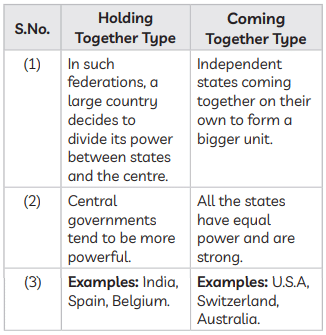
Previous Year Questions 2012
 View Answer
View AnswerQ53: How are the powers divided between the state and the centre in India? Explain with an example. (CBSE 20212)
Ans: The division of power between the central and state governments is done through a three fold distribution of legislative powers between the Union Government and the State Government. This is done through three lists: Union List, State List and Concurrent List.
(1) Union List: It includes subjects of national importance, e.g. defence of the country, foreign affairs, banking, communication and currency. The Central Government makes laws to maintain uniformity on these subjects.
(2) State List: It contains subjects of state and local importance such as police, trade, commerce, agriculture and irrigation.
(3) Concurrent List: It includes those subjects which are of common interest to both the Central as well as State Governments, like education, forests, marriage and trade unions. Both the State and Central Government can make decisions on these matters.
Q54: What is a Gram Sabha? Describe any four functions of a Gram Sabha. (CBSE 2012)
 View Answer
View AnswerAns: A Gram Sabha comprises all the adult citizen voters of the village. It is empowered to support and review the Gram Panchayat body.
The functions of Gram Sabha are:
(1) It elects the members of the Gram Panchayat.
(2) It supervises the work of the Gram Panchayat.
(3) It approves the annual budget of the Panchayat.
(4) It reviews the performance of the Gram Panchayat.
|
64 videos|507 docs|78 tests
|
FAQs on Class 10 Civics Chapter 2 Previous Year Questions - Federalism
| 1. What is federalism and how is it important in a country like India? |  |
| 2. How does the Constitution of India facilitate federalism? |  |
| 3. What are the advantages of federalism in India? |  |
| 4. Can you explain the challenges faced by federalism in India? |  |
| 5. How does federalism contribute to democracy in India? |  |























